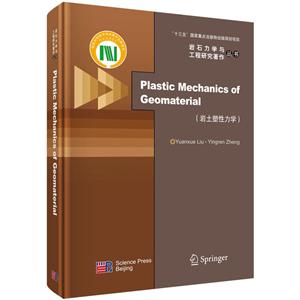扫一扫
关注中图网
官方微博
¥116.6(6.5折)?
预估到手价是按参与促销活动、以最优惠的购买方案计算出的价格(不含优惠券部分),仅供参考,未必等同于实际到手价。
00:00:00
促销活动:
本类五星书更多>
-
>
宇宙、量子和人类心灵
-
>
(精)BBC地球故事系列-星际旅行
-
>
从一到无穷大
-
>
图说相对论(32开平装)
-
>
一本有趣又有料的化学书
-
>
刘薰宇的数学三书:原来数学可以这样学全3册
-
>
光学零件制造工艺学
岩土塑性力学 内容简介
本书是作者关于岩土塑性力学长期教学与科研工作成果的凝聚。力图深入浅出的阐述岩土塑性基本概念、静动力基本力学特性、非线性与经典塑性理论、岩土屈服面理论、硬化模型、流动法则与加卸载准则、主应力轴旋转计算理论,以及岩土极限分析及其*新进展-极限有限元法。较为详细地介绍了代表性的岩土静动力本构模型。期冀读者能对岩土基本力学特性与本构模型有深入系统的认识,可以针对具体工程问题与岩土特性,选用与建立合理本构模型。
岩土塑性力学 目录
Contents1 Introduction 11.1 BasicConcept 11.1.1 Plastic Deformation 11.1.2 Plastic Mechanics 21.1.3 Plastic Mechanics of Geomaterial 31.2 The Basic Hypothesis of Plastic Mechanics of Geomaterial 41.3 The Constitutive Model 41.3.1 What Is Model 41.3.2 Model in Classical Soil Mechanics 51.4 Development History for Plastic Mechanics of Geomaterial 6References 82 Stress and Strain and Its Basic Equations 112.1 Continuum Model 112.2 Stress Tensor 122.3 Decomposition of Stress Tensor and Its Invariants 152.3.1 Decomposition of Stress Tensor 152.3.20 ther Representation of Stress Invariant 162.4 Deformation and Strain 192.5 The Invariant of Strain Tensor 222.6 Decomposition of Strain Tensor and Its Invariants 232.6.1 Decomposition of Strain Tensor 232.6.20 ther Representation of Strain Invariant 242.7 Stress Path and Strain Path 272.7.1 Expression of Stress Path 272.7.2 The Realization of Stress Path 292.7.3 Total Stress Path and Effective Stress Path 292.7.4 Strain Path 302.8 Basic Equations of Plastic Mechanics of Geomaterial 302.8.1 Basic Equations 312.8.2 Boundary Condition and Initial Value 33References 343 The Basic Mechanical Characteristics of the Geomaterial 353.1 Pressure-Hardening 353.2 Yield Caused by Hydrostatic Pressure 363.3 Dilatancy 373.4 Plastic Deformation Dependent on Stress Path 393.50 ther Important Characteristics 413.6 Mechanical Characteristic at Small Strain of Geomaterial 433.7 Mechanical Difference for the Natural and Remoulded Soil 45References 474 The Elastic Model of Geomaterial 494.1 Nonlinear Elastic Theory 514.1.1 Variable Elasticity Theory 514.1.2 Hyperelastic Theory 514.1.3 Hypoelastic Theory 524.2 The Anisotropic Elastic Theory 524.2.1 Isotropic Elastic Constitutive Model 544.2.2 The Elastic Constitutive Model with Cross-Anisotropy 574.3 The Isotropic Nonlinear Elastic Model of Geomaterial 574.3.1 The Basic Principle of Duncan-Chang Model 584.3.2 Two Elastic Function of Duncan-Chang Model 594.3.3 Review of Duncan-Chang Model 634.4 The Elastic Model with Transverse Isotropy 644.4.1 Xiao-nan Gong Model 644.4.2 Graham Model 65References 715 Classical Plastic Theory 735.1 Potential Function and Thermodynamics 735.1.1 First Law of Thermodynamics 735.1.2 Second Law of Thermodynamics 745.1.3 Thermodynamics Potential and Dissipative Inequality 755.2 Plastic Postulate 785.2.1 Drucker's Stability Postulate 785.2.2 Inference of Drucker's Postulate 795.3 The Constitutive Model Based on the Classic Plastic Theory 825.3.1 The Framework of the Classic Plastic Theory 825.3.2 Commonly Used Models 83References 866 The Development of the Plastic Theory of Geomaterial 876.1 Study of Several Basic Problems in Plastic Theory of Geomaterial 876.1.1 Proving that Drucker Postulate Is Unsuitable for Geomaterial 886.1.2 Proving that the Classic Plastic Theory Is Unsuitable for Geomaterial 916.1.3 Study of Several Key Problems in the Plastic Theory of Geomaterial 936.2 Development of the Yield Surface for Geomaterial 976.2.1 Significance of Yield Surface 976.2.2 Yield of Geomaterial 976.2.3 The Shear Yield Surface 986.2.4 Volumetric Yield Criterion 1066.2.5 Yield Surface of Overconsolidated Soil 1146.2.6 Part Yield 1166.3 Hardening Laws 1176.3.1 Hardening Theory 1176.3.2 Hardening Model 1186.3.3 Isotropic Hardening 1196.3.4 Kinematic Hardening 1216.3.5 Mixed Hardening 1246.3.6 The General Form of Hardening Model 1256.4 Plastic Flow Rule 1286.4.1 Associated Flow Rule 1296.4.2 Nonassociated Flow Rule 1296.4.3 Mixed Flow Rule 1296.5 Loading-Unloading Rule 1316.5.1 Loading-Unloading Rule Based on Yield Surface 1316.5.2 Loading-Unloading Rule with Stress Type 1326.5.3 Loading-Unloading Rule with Strain Style 132References 1347 The Static Elastoplastic Model for Geomaterial 1377.1 Cam-Clay and Modified Cam-Clay Model 1387.1.1 The Concept of Critical States 1387.1.2 Cam-Clay Model 1397.1.3 Modified Cam-Clay Model 1447.1.4 Comment on Cam-Clay Model 1457.2 Lade Model 1467.2.1 Components of Constitutive Model 1467.2.2 Elastic Behavior 1467.2.3 Failure Criterion 1477.2.4 Plastic Potential and Flow Rule 1487.2.5 Yield Criterion and Work-Hardening/Softening Relation 1507.2.6 Determination of Material Parameters 1537.2.7 Model Comments 1607.3 A Unified Hardening Constitutive Model for Soils 1617.3.1 Introduction 1617.3.2 The Unified Hardening Parameter Which Has Nothing to Do with the Stress Path 1627.3.3 Unified Hardening Model for Natural Consolidation7.3.4 The Unified Hardening Model of the NormalConsolidated Soil 1707.3.5 The Stress-Strain Relationship 175
展开全部
书友推荐
- >
唐代进士录
唐代进士录
¥17.1¥39.8 - >
新文学天穹两巨星--鲁迅与胡适/红烛学术丛书(红烛学术丛书)
新文学天穹两巨星--鲁迅与胡适/红烛学术丛书(红烛学术丛书)
¥9.9¥23.0 - >
巴金-再思录
巴金-再思录
¥33.1¥46.0 - >
上帝之肋:男人的真实旅程
上帝之肋:男人的真实旅程
¥19.3¥35.0 - >
我与地坛
我与地坛
¥16.8¥28.0 - >
随园食单
随园食单
¥20.6¥48.0 - >
人文阅读与收藏·良友文学丛书:一天的工作
人文阅读与收藏·良友文学丛书:一天的工作
¥16.0¥45.8 - >
罗曼·罗兰读书随笔-精装
罗曼·罗兰读书随笔-精装
¥40.6¥58.0
本类畅销
-
2022图书×抽奖盲袋
¥9.9¥25 -
2023读书月阅读盲盒——天黑,闭眼,刀谁?
¥42.3¥158 -
2022读者节纪念徽章-三星会员专属
¥45¥45.6 -
2023读书月阅读盲盒——我什么场面没见过?
¥42.3¥158 -
2023读书月阅读盲盒——去码头整点什么薯条?
¥42.3¥158



















